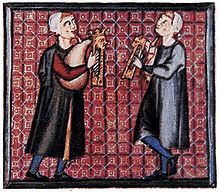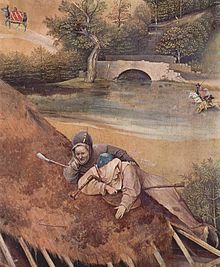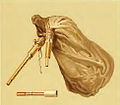Bagpipes: Difference between revisions
cut blog ref and unsourced criticism |
|||
| Line 45: | Line 45: | ||
[[File:Cantiga bagpipes 1.jpg|thumb|right|A detail from the [[Galician language|Galician]] [[Cantigas de Santa Maria]] showing bagpipes with one chanter and a parallel drone (13th Century).]] |
[[File:Cantiga bagpipes 1.jpg|thumb|right|A detail from the [[Galician language|Galician]] [[Cantigas de Santa Maria]] showing bagpipes with one chanter and a parallel drone (13th Century).]] |
||
In the early part of the second millennium, bagpipes began to appear with frequency in European art and iconography. The [[Cantigas de Santa Maria]], compiled in [[Castile (historical region)|Castile]] in the mid-13th century, depict several types of bagpipes.<ref>Elizabeth Aubrey [http://books.google.com/books?id=1nqgFob3uV0C&pg=PA261&lpg=PA261&dq=cantigas+bagpipes&source=web&ots=q1GNc31gal&sig=VjVX8WSGbSiV0712SQctsaLB53I&hl=en The Music of the Troubadours] 1996.</ref> Though evidence of bagpipes in the British Isles prior to the 14th century is contested, bagpipes are explicitly mentioned in [[The Canterbury Tales]] (written around 1380): ''A baggepype wel coude he blowe and sowne, /And ther-with-al he broghte us out of towne.''<ref>Chaucer. The Canterbury Tales. [http://www.bartleby.com/40/0103.html Prologue to "The Miller's Tale"], line 565.</ref> |
In the early part of the second millennium, bagpipes began to appear with frequency in European art and [http://www.collalembolic.com/partituras-para-dol%C3%A7aina/ iconography]. The [[Cantigas de Santa Maria]], compiled in [[Castile (historical region)|Castile]] in the mid-13th century, depict several types of bagpipes.<ref>Elizabeth Aubrey [http://books.google.com/books?id=1nqgFob3uV0C&pg=PA261&lpg=PA261&dq=cantigas+bagpipes&source=web&ots=q1GNc31gal&sig=VjVX8WSGbSiV0712SQctsaLB53I&hl=en The Music of the Troubadours] 1996.</ref> Though evidence of bagpipes in the British Isles prior to the 14th century is contested, bagpipes are explicitly mentioned in [[The Canterbury Tales]] (written around 1380): ''A baggepype wel coude he blowe and sowne, /And ther-with-al he broghte us out of towne.''<ref>Chaucer. The Canterbury Tales. [http://www.bartleby.com/40/0103.html Prologue to "The Miller's Tale"], line 565.</ref> |
||
Actual examples of bagpipes from before the 18th century are extremely rare; however, a substantial number of paintings, carvings, engravings, manuscript illuminations, and so on survive. They make it clear that bagpipes varied hugely throughout Europe, and even within individual regions. Many examples of early folk bagpipes in Continental Europe can be found in the paintings of Brueghel, Teniers, Jordaens and Durer.<ref>[http://www.northport-bagpipes.org/bagpipes.htm] The Great Highland Bagpipes</ref> |
Actual examples of bagpipes from before the 18th century are extremely rare; however, a substantial number of paintings, carvings, engravings, manuscript illuminations, and so on survive. They make it clear that bagpipes varied hugely throughout Europe, and even within individual regions. Many examples of early folk bagpipes in Continental Europe can be found in the paintings of Brueghel, Teniers, Jordaens and Durer.<ref>[http://www.northport-bagpipes.org/bagpipes.htm] The Great Highland Bagpipes</ref> |
||
Revision as of 10:50, 18 November 2011

Bagpipes are a class of musical instrument, aerophones, using enclosed reeds fed from a constant reservoir of air in the form of a bag. Though the Scottish Great Highland Bagpipe and Irish uilleann pipes have the greatest international visibility, bagpipes of many different types come from different regions throughout Europe, Northern Africa, the Persian Gulf, and the Caucasus.
The term "bagpipe" is equally correct in the singular or plural, although in the English language, pipers most commonly talk of "the pipes", "a set of pipes" or "a stand of pipes".
Pakistan is one of the world's largest producers of bagpipes and is the second largest exporter after Scotland.[citation needed]
Overview
A set of bagpipes minimally consists of an air supply, a bag, a chanter, and usually a drone. Most bagpipes also have additional drones (and sometimes chanters) in various combinations, held in place in stocks—connectors that fasten the various pipes to the bag.
Air supply
The most common method of supplying air to the bag is by blowing into a blowpipe, or blowstick. In some pipes the player must cover the tip of the blowpipe with his tongue while inhaling, but modern blowpipes have a non-return valve that eliminates this need.
An innovation, dating from the 16th or 17th centuries, is the use of a bellows to supply air. In these pipes, sometimes called cauld wind pipes, air is not heated or moistened by the player's breathing, so bellows-driven bagpipes can use more refined and/or delicate reeds. The most famous of these pipes are the Irish uilleann pipes, the Northumbrian smallpipes in Britain, and the Musette de cour in France.
Bag
The bag is an airtight reservoir that can hold air and regulate its flow while the player keeps the bag inflated by blowing into it or pumping with a bellows, enabling the player to maintain continuous sound for some time. Materials used for bags vary widely, but the most common are the skins of local animals such as goats, dogs, sheep, and cows. More recently, bags made of synthetic materials including Gore-Tex have become much more common.
Bags cut from larger materials are usually saddle-stitched with an extra strip folded over the seam and stitched (for skin bags) or glued (for synthetic bags) to reduce leaks. Holes are then cut to accommodate the stocks. In the case of bags made from largely intact animal skins the stocks are typically tied into the points where limbs and the head joined the body of the living animal, a construction technique common in Central and Eastern Europe.
Chanter
The chanter is the melody pipe, played by two hands. A chanter can be bored internally so that the inside walls are parallel for its full length, or it can be bored in the shape of a cone. Additionally, the reed can be a single or a double reed. Double reeds are used with both conical- and parallel-bored chanters while single reeds are generally (although not exclusively) limited to parallel-bored chanters. In general double-reed chanters are found in pipes of Western Europe with single-reed chanters found elsewhere.

The chanter is usually open-ended; thus, there is no easy way for the player to stop the pipe from sounding. This means that most bagpipes share a legato sound where there are no rests in the music. Primarily because of this inability to stop playing, grace notes (which vary between types of bagpipe) are used to break up notes and to create the illusion of articulation and accents. Because of their importance, these embellishments (or ornaments) are often highly technical systems specific to each bagpipe, and take many years and much study to master.
A few bagpipes (the musette de cour, the uilleann pipes, the Northumbrian smallpipe, and the left chanter of the surdulina, a type of Calabrian zampogna) have closed ends or stop the end on the player's leg, so that when the player covers all the holes (known as closing the chanter) it becomes silent.
Drone
Most bagpipes have at least one drone. The Great Highland Bagpipe has three: a bass drone and two tenor drones. A drone is most commonly a cylindrical tube with a single reed, although drones with double reeds exist. The drone is generally designed in two or more parts, with a sliding joint ("'bridle'") so that the pitch of the drone can be manipulated.
Depending on the type of pipes, the drones may lie over the shoulder, across the arm opposite the bag, or may run parallel to the chanter. Some drones have a tuning screw, which effectively alters the length of the drone by opening a hole, allowing the drone to be tuned to two or more distinct pitches. The tuning screw may also shut off the drone altogether. In most type of pipes, where there is one drone it is pitched two octaves below the tonic of the chanter, and further additions often add the octave below and then a drone consonant with the fifth of the chanter.
History
Possible ancient origins
Evidence of pre-medieval bagpipes is uncertain, but several textual and visual clues may possibly indicate ancient forms of bagpipes. The "Oxford History of Music" makes mention of the first documented bagpipe being found on a Hittite slab at Eyuk in the Middle East. This sculptured bagpipe has been dated to 1000 BC. In the 2nd century AD, Suetonius described the Roman Emperor Nero as a player of the tibia utricularis.[1] Dio Chrysostom, who also flourished in the 1st century, wrote about a contemporary sovereign (possibly Nero) who could play a pipe (tibia, Roman reedpipes, similar to Greek aulos) with his mouth as well as with his "armpit".[2] From this account, it could suggest that the tibia utricularis was a bagpipe.
Spread and development in Europe

In the early part of the second millennium, bagpipes began to appear with frequency in European art and iconography. The Cantigas de Santa Maria, compiled in Castile in the mid-13th century, depict several types of bagpipes.[3] Though evidence of bagpipes in the British Isles prior to the 14th century is contested, bagpipes are explicitly mentioned in The Canterbury Tales (written around 1380): A baggepype wel coude he blowe and sowne, /And ther-with-al he broghte us out of towne.[4]
Actual examples of bagpipes from before the 18th century are extremely rare; however, a substantial number of paintings, carvings, engravings, manuscript illuminations, and so on survive. They make it clear that bagpipes varied hugely throughout Europe, and even within individual regions. Many examples of early folk bagpipes in Continental Europe can be found in the paintings of Brueghel, Teniers, Jordaens and Durer.[5]

Evidence of the bagpipe in Ireland occurs in 1581, when John Derrick's "The Image of Irelande" clearly depicts a bagpiper. Derrick's illustrations are considered to be reasonably faithful depictions of the attire and equipment of the English and Irish population of the 16th century.[6] The Battle sequence from My Ladye Nevells Booke (1591) by William Byrd, which probably alludes to the Irish wars of 1578, contains a piece entitled The bagpipe: & the drone. In 1760, the first serious study of the Scottish Highland bagpipe and its music was attempted, in Joseph MacDonald's 'Compleat Theory'. Further south, a manuscript from the 1730s by a William Dixon from Northumberland contains music that fits the Border pipes, a nine-note bellows-blown bagpipe whose chanter is similar to that of the modern Great Highland Bagpipe. However the music in Dixon's manuscript varied greatly from modern Highland bagpipe tunes, consisting mostly of extended variation sets of common dance tunes. Some of the tunes in the Dixon manuscript correspond to tunes found in early 19th century published and manuscript sources of Northumbrian smallpipe tunes, notably the rare book of 50 tunes, many with variations, by John Peacock.

As Western classical music developed, both in terms of musical sophistication and instrumental technology, bagpipes in many regions fell out of favour due to their limited range and function. This triggered a long, slow decline that continued, in most cases, into the 20th century.
Extensive and documented collections of traditional bagpipes can be found in the Musical Instrument section of the Metropolitan Museum of Art in New York City, and at the International Bagpipe Museum in Gijón, Spain, and Pitt Rivers Museum in England.
Recent history

During the expansion of the British Empire, spearheaded by British military forces that included Highland regiments, the Scottish Great Highland Bagpipe became well-known worldwide. This surge in popularity was boosted by large numbers of pipers trained for military service in the First and Second World War. The surge coincided with a decline in the popularity of many traditional forms of bagpipe throughout Europe, which began to be displaced by instruments from the classical tradition and later by gramophone and radio.
In the United Kingdom and Commonwealth Nations such as Canada and New Zealand, the bagpipe is commonly used in the military and is often played in formal ceremonies. Foreign militaries patterned after the British Army have also taken the Highland bagpipe into use, including Uganda, India, Pakistan, Sri Lanka, and Oman. Many police and fire forces in Scotland, Canada, Australia, New Zealand, Hong Kong, and the United States have also adopted the tradition of pipe bands.
In recent years, often driven by revivals of native folk music and dance, many types of bagpipes have resurged in popularity, and in many cases instruments that were on the brink of extinction have become extremely popular. In Brittany, the Great Highland Bagpipe and concept of the pipe band were appropriated to create a Breton interpretation, the bagad. The pipe band idiom has also been adopted and applied to the Spanish gaita as well. Additionally, bagpipes have often been used in various films depicting moments from Scottish and Irish history; the film Braveheart and the theatrical show Riverdance have served to make the uilleann pipes more commonly known.
In the late 20th century, various models of electronic bagpipes were invented. The first custom-built MIDI bagpipes were developed by the Asturian piper known as Hevia (José Ángel Hevia Velasco).[7]
Modern usage
Types of bagpipes
Dozens of types of bagpipes today are widely spread across Europe and the Middle East, as well as through much of the former British Empire. The name bagpipe has almost become synonymous with its best-known form, the Great Highland Bagpipe, overshadowing the great number and variety of traditional forms of bagpipe. Despite the decline of these other types of pipes over the last few centuries, in recent years many of these pipes have seen a resurgence or even revival as traditional musicians have sought them out; for example, the Irish piping tradition, which by the mid 20th century had declined to a handful of master players is today alive, well, and flourishing a situation similar to that of the Asturian gaita, the Galician gaita, the Aragonese gaita de boto, Northumbrian smallpipes, the Breton biniou, the Balkan gaida, the Black Sea tulum, the Scottish smallpipes and pastoral pipes, as well as other varieties.
Traditionally, one of the main purposes of the bagpipe in most traditions was to provide music for dancing. In most countries this has declined with the growth of dance bands, recordings, and the decline of traditional dance. In turn, this has led to many types of pipes developing a performance-led tradition, and indeed much modern music based on the dance music tradition played on bagpipes is no longer suitable for use as dance music.
-
A Turkish Laz man playing a Tulum
-
Irish Uilleann pipes played by Cillian Vallely
-
Kathryn Tickell playing the Northumbrian smallpipes
-
A man from Skopje playing the Gaida
-
A performance on the Galician gaita
-
A sruti upanga, a Southern Indian bagpipe
-
A Hungarian Duda
-
A Serbian bagpiper
-
Polish bagpipers
-
The Bagad of Lann Bihoué from the French Navy
-
Säckpipa Swedish bagpipes
-
Pastoral pipes with removable footjoint and bellows
-
An Estonian bagpiper
-
Modern German Hümmelchen -
A woman with a Asturian gaita
Usage in non-traditional music

Since the 1960s, bagpipes have also made appearances in other forms of music, including rock, metal, jazz, hip-hop, punk, and classical music, for example with Paul McCartney's "Mull of Kintyre", AC/DC's "It's A Long Way To The Top", Korn's "Shoots and Ladders", John Farnham's "You're The Voice" and Peter Maxwell Davies's composition Orkney Wedding, With Sunrise.
Publications about the bagpipes
Periodicals
Periodicals covering specific types of bagpipes are addressed in the article for that bagpipe
- Chanter, published by The Bagpipes Society
- Utriculus, published by Circolo della Zampogna, Italy
Books
- The Book of the Bagpipe, Hugh Cheape
- Bagpipes, Anthony Baines, ISBN 0-902793-10-1, Pitt Rivers Museum, Univ. of Oxford, 3rd edition, 1995 147 pages with plates
- Woodwind Instruments & Their History, Anthony Baines, ISBN 0-486-26885-3, Nov. 1991, Dover Pub., with Bagpipe plates
- The Bagpipe, The History of a Musical Instrument, Francis Collinson, 1975
See also
- List of bagpipes
- List of bagpipers
- List of pipe makers
- List of pipe bands
- List of published bagpipe music
- List of nontraditional bagpipe usage
- List of bagpipe technology books
- List of composers who employed pipe music
- Glossary of bagpipe terms
- Practice chanter
References
- ^ (Life of Nero, 54)
- ^ (Or. 71.9)
- ^ Elizabeth Aubrey The Music of the Troubadours 1996.
- ^ Chaucer. The Canterbury Tales. Prologue to "The Miller's Tale", line 565.
- ^ [1] The Great Highland Bagpipes
- ^ John Derrick The Image of Irelande London, 1581.
- ^ CNN - WorldBeat Spotlight - Bagpipes resonate through rugged coastline of... Spain - November 5, 1999

















